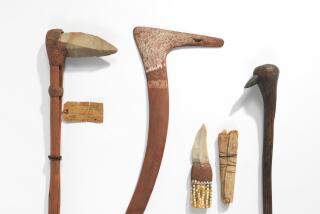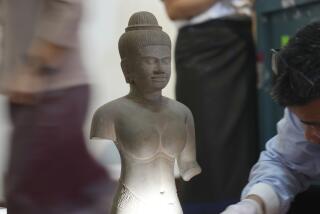Getty to Return Three Ancient Pieces to Italy
Italian authorities have agreed to accept an offer from the J. Paul Getty Museum to return three ancient objects allegedly stolen from Italy, but say they jhuwill continue to pursue dozens more artifacts in a separate criminal case against the museumâs former antiquities curator.
The Gettyâs offer came after protracted negotiations with Italian authorities, and it figures prominently in the museumâs strategy of building goodwill with the Italian government, records show.
The Italians have presented evidence that each of the three items was looted from Italian tombs or taken from collections in Italy, in violation of the countryâs patrimony laws.
One, an ancient urn believed to have been painted by the Greek artist Asteas about 340 BC, was the subject of a forfeiture complaint filed by U.S. authorities on behalf of the Italian government last year. The complaint details how the object was unearthed in Italy by an excavator in 1974, sold to a smuggler for a pig, and purchased by the Getty from a Swiss art dealer in 1981 for $275,000.
In a statement released Monday, the museum said: âAlthough the Getty believes that it had valid defenses to the claims asserted in the petition, it reached an agreement with the Italian authorities in the interests of settling the litigation and demonstrating the Gettyâs interest in a productive relationship with Italy.
âThe Getty based its decision to offer to return the other two objects -- a bronze Etruscan candelabrum and stone inscription -- on its own evaluation of evidence presented by the Italian government.â
The return of the objects is not directly related to the Italian criminal case against the Gettyâs former curator for antiquities, Marion True, who faces trial in Rome for allegedly conspiring to traffic in looted art with a network of antiquities dealers. In that case, Italian authorities have identified 42 objects acquired by the Getty that allegedly were looted from Italy.
However, there is overlap between the two proceedings.
The Asteas urn is part of a criminal case against the dealer who sold it to the Getty, Gianfranco Becchina, Italian authorities said Monday. Becchina is part of the network of dealers who have been charged, along with True, with conspiracy.
âItâs the same criminal conspiracy, but a separate legal proceeding,â Paolo Ferri, the Italian prosecutor in the case against True, said in a phone interview Monday.
In addition, one of the three objects being returned by the Getty is part of the criminal case against True, who retired from the Getty over the weekend. The candelabrum is a companion piece to an ancient tripod that the museum returned to Italy in 1996 after learning that the tripod had been part of an Italian collection. True purchased both objects in 1990 from a New York gallery associated with Robert Hecht, a Paris-based antiquities dealer who now faces trial in Rome as her co-defendant, records show.
Italian authorities say the candelabrum was removed illegally from the same private Italian collection and smuggled to Switzerland, a claim that Hecht has disputed.
After the Italian prosecutor announced that True was a target of their investigation in 2000, the Gettyâs outside legal counsel recommended that the Getty shift to a âdefensive strategyâ that included meeting with senior Ministry of Culture officials, records show. After the museumâs director failed to reach an agreement with Italian authorities in 2003, the Gettyâs general counsel, Peter Erichsen, wrote to senior Ministry of Culture officials offering a deal. The Getty would return the three antiquities in exchange for guarantees that the Italians would not go after other objects at the museum, records show.
Erichsen described the Gettyâs offer as âan extraordinary effort to demonstrate its goodwill to the Italian government.â
The Italian authorities have accepted the return of the three objects but say they will continue to pursue other objects they say were looted.
True retired from her post after the Getty determined she had violated museum policies by accepting a $400,000 loan with the assistance of one of the museumâs antiquities dealers a decade ago. Her departure will not affect the public opening of the refurbished and expanded Getty Villa, which is still on track for late January, a museum spokesman said Monday.
Karol Wight, associate curator of antiquities, who has written and contributed to several books on the Gettyâs collections, will be appointed acting curator of antiquities. A 20-year Getty veteran, she will oversee a curatorial staff of seven.
*
Times staff writers Scott Martelle, Suzanne Muchnic and Ralph Frammolino contributed to this report.
More to Read
Sign up for Essential California
The most important California stories and recommendations in your inbox every morning.
You may occasionally receive promotional content from the Los Angeles Times.










